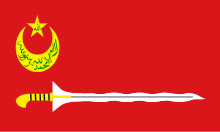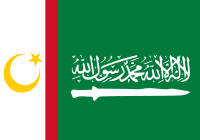Dos Palmas kidnappings
| Dos Palmas kidnappings of 2001 | |
|---|---|
| Part of Islamic insurgency in the Philippines | |
.svg.png) Dos Palmas Resort, Honda Bay Dos Palmas Resort, Honda Bay (Philippines) Location of Dos Palmas Resort in Palawan | |
| Coordinates | Coordinates: 9°54′00″N 118°47′00″E / 9.9°N 118.783333°E |
| Date | May 27, 2001 – June 7, 2002 (UTC+8) |
| Target | Local and foreign tourists |
Attack type | Hostage situation |
| Weapons | Automatic weapons, Grenades and Rocket Propelled Grenades |
| Deaths | More than 40 |
Non-fatal injuries | Numerous |
| Victims | Guillermo Sobero and Martin Burnham |
| Perpetrators | Around 40 Islamist militants |
The Dos Palmas kidnappings was a hostage crisis in the southern Philippines that began with the seizing of twenty hostages from the affluent Dos Palmas Resort on a private island in the Honda Bay, Palawan, by members of Abu Sayyaf on May 27, 2001 and resulted in the deaths of at least five of the original hostages, including the two American citizens, Guillermo Sobero and Martin Burnham.[1] At least 22 Filipino soldiers were killed in attempts to apprehend the captors and free the hostages in the 12 months following the initial hostage taking.[2] An unknown number of captors were killed by government forces.
The crisis
During the crisis the number of those taken captive varied greatly as more hostages were seized in numerous raids on the island of Basilan; therefore, a total of those taken prisoner at some point may be impossible to determine.[3] However, news reports suggested at least 100 hostages were taken and around 20 murdered in just over a year up until the final assault and freeing of Gracia Burnham on June 7, 2002.[3] Even some local and foreign journalists covering the high-profile kidnappings were themselves held captive for some time.[4]
Abduction
Gunmen arrived in two boats early on May 27, 2001 at a resort in Honda Bay to the north of Puerto Princesa City on the island of Palawan. They proceeded to abduct without incident 20 people from the resort, including four resort staff and three Americans, identified as Martin and Gracia Burnham, missionaries from the state of Kansas who were celebrating their 18th wedding anniversary, and Guillermo Sobero, a Peruvian-born American from California.[5][2][6] Most of those seized were ethnic Chinese Filipino tourists.
The hostages and hostage-takers returned hundreds of kilometres back across the Sulu Sea to the Abu Sayyaf's territories in Mindanao.[3]
Lamitan siege
Four Filipino nationals of the initial twenty hostages taken from the Dos Palmas resort were able to escape in the days up to June 1, 2001.[6] However, on June 2, a large group of up to 40 gunmen were able to take control of the Dr. Jose Torres Memorial Hospital and St. Peter's Church compound in the town of Lamitan,[4] Basilan, and would later state they had taken 200 people captive.[7] Authorities would only confirm about 20 people were seized, including patients and doctors from the hospital.[6][7]
Reportedly the remaining hostages from the initial group taken in Palawan, including all three US nationals, were held in Lamitan.[2] Witnesses in Lamitan described helicopters and infantry units pouring rockets and machine gun fire into the hospital and church compound as troops came under fire from rooftop snipers,[2] killing up to 12 soldiers, including an army captain.[7] Reports indicated twenty-two soldiers had been killed since the initial hostages were seized.[8]
Five more Filipino captives escaped during the fighting in Lamitan,[2][7] but Abu Sayyaf had killed two hostages in the days before, beheading one.[2] A large contingent of rebels reportedly broke through the military cordon during the night of June 4 while several members of their group stayed behind to hold their positions.[2]
President Gloria Macapagal Arroyo vowed to fight the rebels and warned the Abu Sayyaf group to give themselves up or be killed, stating in a television broadcast, "We will finish off all the bandits if they don't surrender at the earliest possible time... to the Abu Sayyaf: You have nowhere else to run."[2]
Further raids
According to the author Mark Bowden, Abu Sayyaf captors conducted numerous raids, "including one at a coconut plantation called Golden Harvest; they took about 15 people captive there and later used bolo knives to hack the heads off two men. The number of hostages waxed and waned as some were ransomed and released, new ones were taken and others were killed."[3] Four children, including two 12-year-olds, were among the hostages taken from the coconut plantation in the Lantawan area of Basilan, a military spokesman said.[9] The owners and a security guard were also taken, and two buildings, including a chapel, were burnt down during the raid a week after that in Lamitan.[9]
By June 13 the number held captive was calculated at around 28 people, as 3 more people were found beheaded on Basilan.[10] One of the bodies was that of a Muslim cleric who had privately tried to negotiate with the kidnappers.[10] Abu Sabaya, the Abu Sayyaf spokesman, stated he had beheaded Guillermo Sobero on the Philippine day of independence, June 12, as the security forces would not halt a rescue operation. Sobero's death was later confirmed in October 2001, after his body was found in a shallow grave in Basilan.[11]
On August 2, 2001, suspected Abu Sayyaf militants captured 32 to 35 villagers in a raid on Balobo town in Lamitan, Basilan.[12] However, on August 5, the Philippine Army rescued 13 of the Filipino hostages, including several children, after a gun battle with the Abu Sayyaf captors.[13] An army spokesman stated the hostages were freed before dawn, when the soldiers stormed the militants' hideout outside the town of Isabela and that the guerrillas had beheaded around 11 hostages,[12] while several others were either released or had escaped.[13]
Conclusion of hostage taking
By October 2001 the Burnhams were among a group of 14 still being held by the guerrillas, according to three Filipino hostages who escaped from the group in mid-October.[11] Bertram Benasing, who escaped with his 14-year-old brother Zardi and Michael Abellion, said they had walked overnight after being sent to fetch water and bananas on the island of Basilan.[11] A video taken in November 2001 apparently showed the Burnhams in poor health, with Martin saying "each night I am chained to a tree by my left wrist."[1]
The kidnappers demanded $1,000,000 for the release of the Americans. A ransom of $330,000 was paid, yet the kidnappers refused to release them. On June 7, 2002, after over a year in captivity, Martin Burnham and a Filipino nurse, Ediborah Yap, died in an operation to free them, while Burnham's wife Gracia was wounded.[1] Martin was killed by three gunshots in the chest and Gracia was wounded in her right leg.
Upon hearing of Mr. Burnham's death, the then US President George W. Bush expressed his grief, saying, "First let me say how sad we are that Martin Burnham lost his life... I'm pleased that Mrs Burnham is alive. That's good."[1] Most other hostages were reportedly released for ransom.[1]
President Arroyo defended the operation, saying "our soldiers tried their best to hold their fire for their (the hostages') safety. I salute our troops for their forbearance. The terror shall not be allowed to get away with this. We shall not stop until the Abu Sayyaf is finished. The battle shall go on, wherever it takes."[1]
Subsequent events
The search for the hostages eventually led to a six-month deployment of 1,000 American troops who provided training and high-tech support to the Filipino troops.
In July 2004, Gracia Burnham testified at a trial of eight Abu Sayyaf members and identified six of the suspects as being her erstwhile captors, including Alhamzer Limbong, Abdul Azan Diamla, Abu Khari Moctar, Bas Ishmael, Alzen Jandul and Dazid Baize.
"The eight suspects sat silently during her three-hour testimony, separated from her by a wooden grill. They face the death sentence if found guilty of kidnapping for ransom. The trial began this year and is not expected to end for several months."[14]
Fourteen Abu Sayyaf bandits were sentenced to life imprisonment on December 6, 2007 as result of the attacks; four were acquitted.[15] Alhamzer Limbong was later killed in a prison uprising.[16]
References
- 1 2 3 4 5 6 "Hostages die in Philippine rescue bid". BBC News. June 7, 2002. Retrieved March 23, 2010.
- 1 2 3 4 5 6 7 8 "Philippines hostage search begins". BBC News. May 27, 2001. Retrieved March 23, 2010.
- 1 2 3 4 "Manhunt", Mark Bowden, The Atlantic, March 2007, p.54 (15)
- 1 2 "Abu Sayyaf kidnappings, bombings and other attacks". GMA News. August 23, 2007. Retrieved March 22, 2010.
- ↑ Conde, Carlos H. (December 7, 2007). "Philippine Court Convicts 14 in Kidnapping Case". New York Times.
- 1 2 3 "Philippines hostage crisis deepens". BBC News. June 2, 2001. Retrieved March 23, 2010.
- 1 2 3 4 "Abu Sayyaf bandits kill two hostages, escape military siege". CDNN. June 4, 2001. Retrieved March 23, 2010.
- ↑ "Philippine rebels escape siege". BBC News. June 3, 2001. Retrieved March 23, 2010.
- 1 2 "Philippines Offer Averts Beheading". BBC News. June 11, 2001. Retrieved March 23, 2010.
- 1 2 "Philippines bodies identified". BBC News. June 13, 2001. Retrieved March 23, 2010.
- 1 2 3 "U.S. Hostage Confirmed Dead". BBC News. October 12, 2001. Retrieved March 23, 2010.
- 1 2 "Balobo Killings in Basilan Province, August 2, 2001". Human Rights Watch. July 2007. Retrieved March 23, 2010.
- 1 2 "Hostages Rescued in the Philippines". BBC News. August 5, 2002. Retrieved March 23, 2010.
- ↑ "Burham identifies former Abu Captors" (PDF). Retrieved June 6, 2006.
- ↑ "14 Abus sentenced to life for Dos Palmas incident | News | GMA News Online | The Go-To Site for Filipinos Everywhere". Gmanews.tv. December 6, 2007. Retrieved February 6, 2006.
- ↑ PHILIPPINES BRACE FOR RETALIATION Tuesday, March 15, 2005, Associated Press

